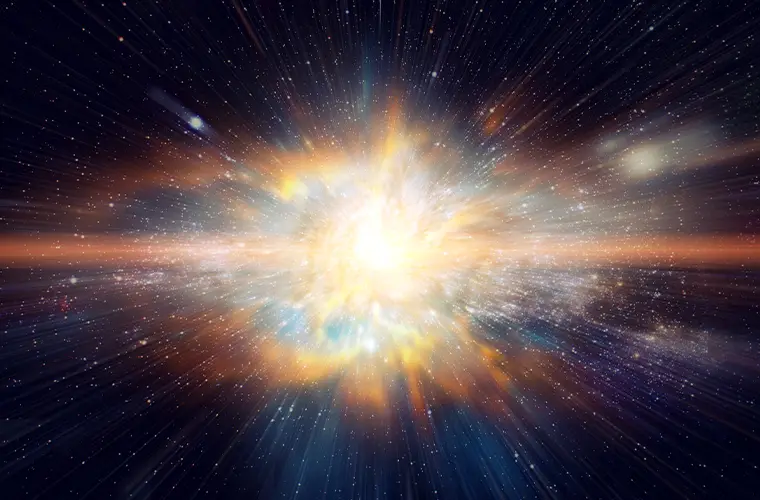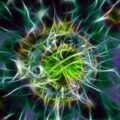A recent observational study is challenging one of modern science’s most widely accepted theories: the Big Bang.
The findings, published in the scientific journal Particles, suggest that the universe’s expansion may not have been driven by a massive explosion billions of years ago but rather by an alternative, “fringe” explanation that’s been around for nearly a century—the “Tired Light” theory.
“The tired light theory was largely neglected, as astronomers adopted the Big Bang theory as the consensus model of the universe,” Dr. Lior Shamir, study author and associate professor of computer science at Kansas State University, said in a release. “But the confidence of some astronomers in the Big Bang theory started to weaken when the powerful James Webb Space Telescope saw first light.”
“The JWST provided deep images of the very early universe, but instead of showing an infant early universe as astronomers expected, it showed large and mature galaxies. If the Big Bang happened as scientists initially believed, these galaxies are older than the universe itself.”
The Big Bang theory has long been the prevailing explanation for the universe’s origin. According to this theory, the universe began around 13.8 billion years ago from an extremely hot and dense singularity, expanding rapidly and cooling over time.
This event is believed to have set the foundation for the cosmos, leading to the formation of galaxies, stars, and planets. The Big Bang theory is supported by several lines of evidence, such as the cosmic microwave background radiation, the distribution of galaxies, and the observed redshift of light from distant galaxies, which implies that the universe is expanding.
However, in this new study, Dr. Shamir suggests that redshift—a phenomenon where light from distant objects shifts toward the red end of the spectrum, indicating they are moving away—might not necessarily prove that the universe is expanding in the way the Big Bang theory suggests. Instead, evidence could support an alternative: the “Tired Light” theory.
First proposed in 1929 by Swiss astronomer Dr. Fritz Zwicky, the “Tired Light” theory offers a different explanation for the redshift observed in light from distant galaxies.
According to this theory, as light travels through space, it loses energy over vast distances due to interactions with particles or fields, causing it to “tire” and shift to longer wavelengths, such as red.
This process would give the appearance of an expanding universe without requiring an actual outward movement of galaxies from a central point, as proposed by the Big Bang theory.
The “Tired Light” theory was initially sidelined by the scientific community in favor of the Big Bang theory, primarily because it could not fully account for certain observations, such as the cosmic microwave background radiation and surface brightness of galaxies evolving with time.
However, recent observations and analyses, like those presented in this new study, could prompt a re-evaluation of Dr. Zwicky’s hypothesis.
In the newly published paper, Dr. Shamir argues that recent observational data challenges the standard interpretation of redshift as evidence of universal expansion. The study suggests that the tired light model might better explain certain cosmological phenomena, particularly how light behaves over enormous cosmic distances.
The study focuses on discrepancies between observed data and predictions made by the Big Bang model, including the rate of expansion inferred from the redshift data. Dr. Shamir points out that while the Big Bang theory predicts a uniform expansion rate, the observational data shows a more complex picture that could be interpreted through the tired light framework.
Moreover, the study introduces a series of calculations and simulations to demonstrate how the tired light model might align with current data on the universe’s structure and behavior. It suggests that the tired light model could potentially explain phenomena like the Hubble constant‘s inconsistencies — a number that represents the universe’s rate of expansion — which has been a subject of intense debate in the scientific community.
“The results showed that galaxies that rotate in the opposite direction relative to the Milky Way have lower redshift compared to galaxies that rotate in the same direction relative to the Milky Way,” Dr. Shamir said. “That difference reflects the motion of the Earth as it rotates with the Milky Way. But the results also showed that the difference in the redshift increased when the galaxies were more distant from Earth.
“Because the rotational velocity of the Earth relative to the galaxies is constant, the reason for the difference can be the distance of the galaxies from Earth. That shows that the redshift of galaxies changes with the distance, which is what Zwicky predicted in his Tired Light theory.”
The study’s findings do not outright reject the Big Bang theory but call for a broader consideration of alternative explanations that could also fit the available data. Dr. Shamir suggests that the tired light theory deserves renewed attention, particularly given recent advancements in observational technologies that provide a clearer view of cosmic phenomena.
While this new study offers intriguing evidence supporting the “Tired Light” theory, the scientific community will likely approach such claims with caution.
The Big Bang theory has been the dominant cosmological model for nearly a century. It is backed by extensive observational data, including the distribution of galaxies across the universe.
These pillars of evidence have withstood decades of scrutiny, making it unlikely that the scientific community will readily discard the Big Bang theory in favor of an alternative hypothesis without compelling and comprehensive proof.
Similarly, critics have long argued that the tired light theory does not account for all the observed evidence supporting the Big Bang model, such as the cosmic microwave background radiation—the “afterglow” of the Big Bang—and the abundance of light elements like hydrogen and helium.
Nevertheless, the Big Bang theory has its own challenges and unresolved mysteries. For instance, it grapples with issues such as the horizon problem, the flatness problem, and the question of baryon asymmetry in matter. Additionally, critical elements like “dark energy” and “dark matter,” which are necessary to make the Big Bang theory work, remain unexplained.
Dr. Shamir’s recent observational study could prompt scientists to reevaluate the fundamental assumptions behind their understanding of the cosmos. At the very least, it suggests that aspects of cosmic history remain unclear, inviting consideration of alternative ideas about the universe’s origins and expansion.
It remains uncertain whether the tired light theory will gain broader acceptance or be further refined to account for the phenomena that the Big Bang model explains.
What is clear, however, is that this debate is far from over. The universe may still hold surprises that challenge even our most cherished scientific theories.
“The unprecedented imaging power of JWST has revealed new information about the Universe that is not aligned with some of the current fundamental cosmological assumptions,” Dr. Shamir writes. “These puzzling observations introduce a challenge to cosmology: if the distance indicators are accurate, the standard cosmological model is incomplete. If the current standard cosmological theories are complete, then the distance indicators may not be fully accurate.”
“That is, either the standard cosmological theories need to be revised, or the redshift as a distance indicator needs to be revised, but the two may not be able to coexist without modifications.”
Tim McMillan is a retired law enforcement executive, investigative reporter and co-founder of The Debrief. His writing typically focuses on defense, national security, the Intelligence Community and topics related to psychology. You can follow Tim on Twitter: @LtTimMcMillan. Tim can be reached by email: tim@thedebrief.org or through encrypted email: LtTimMcMillan@protonmail.com

